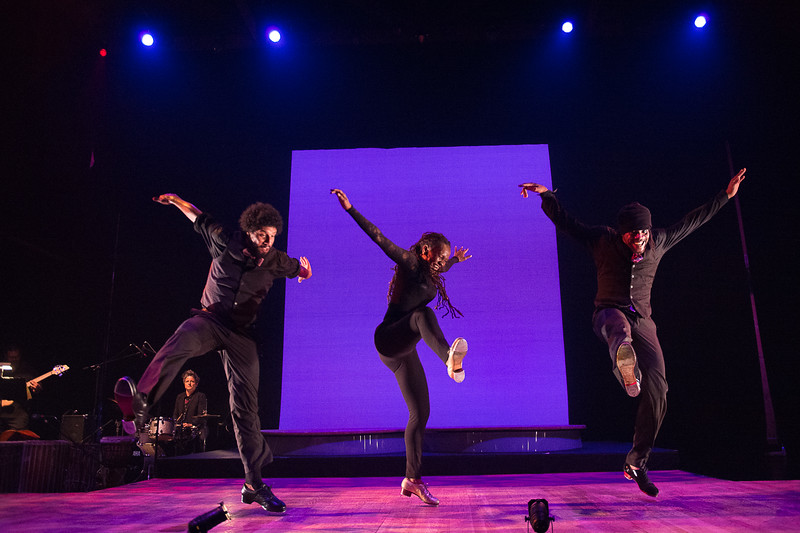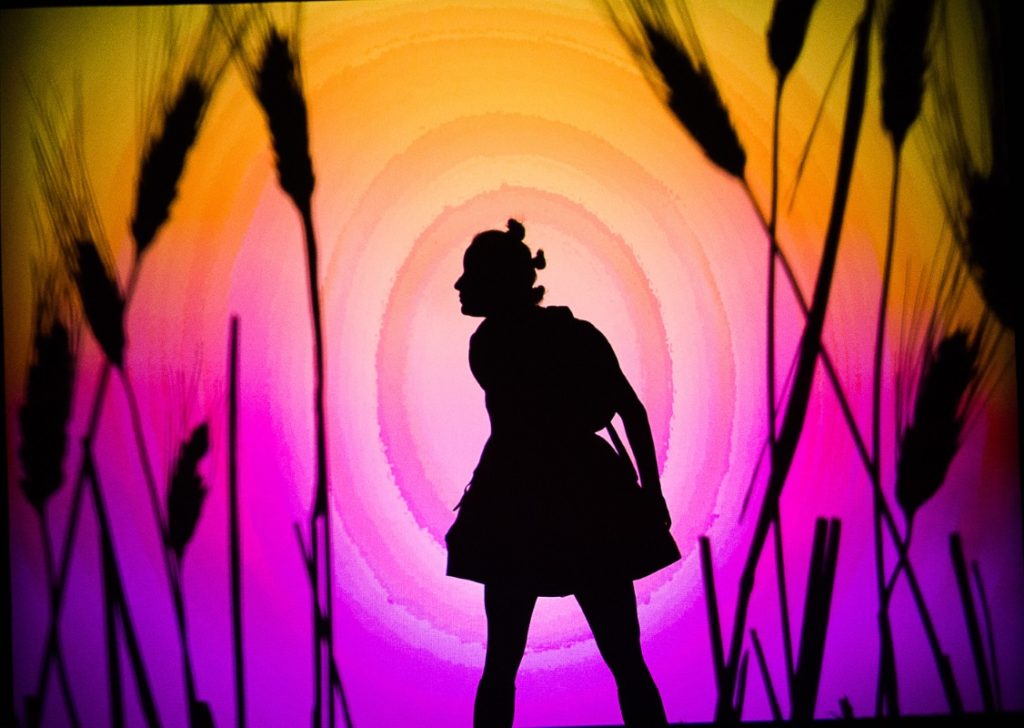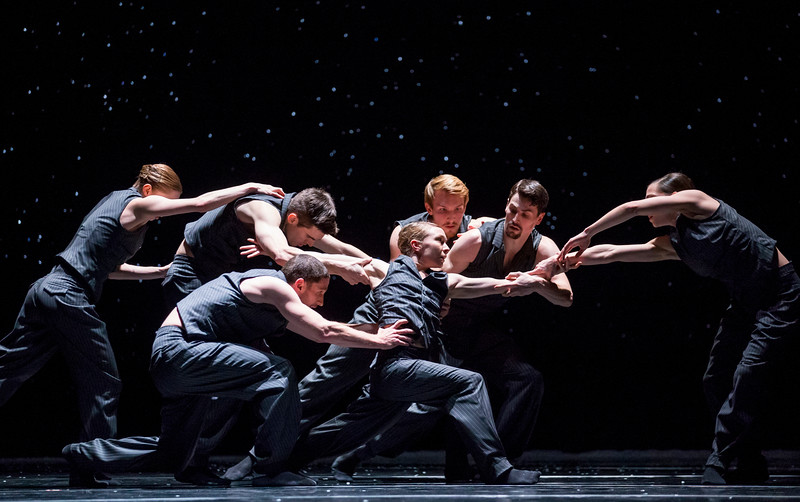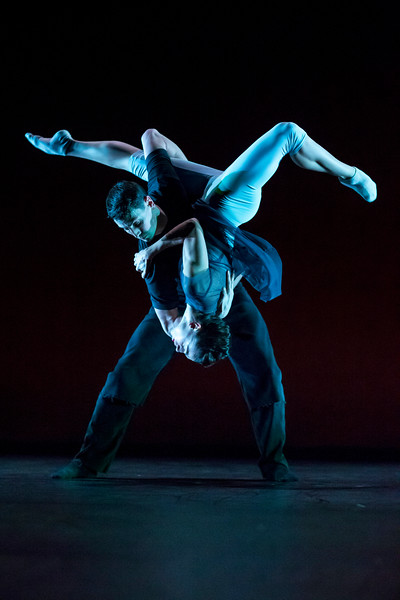If dance is “the hidden language of the soul,” as Martha Graham put it, tap is its least bashful dialect.
For the past few years Jacob’s Pillow, the country’s premier modern dance festival, has featured tap dancing in its eclectic roster of summertime performances. There are two this summer: Michelle Dorrance, who pushes the leading edge of tap exploration ever further, comes back in August. Earlier this month, her friend and colleague Dormeshia Sumbry-Edwards, co-choreographer of Dorrance’s boundary-breaking Blues Project, led the parade with a toe-tapping excursion down another musical highway.
And Still You Must Swing is Sumbry-Edwards’ salute to the music – and the tap artists – of the Swing Era of the forties and early fifties. She and two co-performer/choreographers, Jason Samuels and Derick K. Grant, teamed with a hot three-piece jazz combo led by drummer Allison Miller to evoke a smoky nightclub of yesteryear while continuing to expand the vocabulary of tap – and the very notion of all it embraces – for today’s audience.
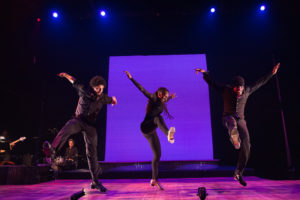 The show looked back beyond the “Great Rebirth” of tap in the seventies and eighties, when these three dancers came of age with Savion Glover’s Bring in ’da Noise, Bring in ’da Funk, to tap’s Golden Age, personified by the likes of Bill “Bojangles” Robinson and Jimmy Slyde (the show’s title is a Slyde quote).
The show looked back beyond the “Great Rebirth” of tap in the seventies and eighties, when these three dancers came of age with Savion Glover’s Bring in ’da Noise, Bring in ’da Funk, to tap’s Golden Age, personified by the likes of Bill “Bojangles” Robinson and Jimmy Slyde (the show’s title is a Slyde quote).
Black-clad and gold-shoed, solo and together, the three dancers cooked up a seamless interplay of rhythm and melody with the band. Sometimes the tappers set the tempo with a few deft footfalls, sometimes they followed the musicians’ lead, and often it was impossible to know who was setting the pace, as dancers and musicians traded riffs back and forth. (Grant’s showcase solo was essentially an improvised, slow-groove duet with pianist Carmen Staaf that drew on moves and gestures of tap’s old masters while also quoting briefly from The Cure.)
The choreography was often structured like jazz arrangements: a unison trio establishing the theme with set moves, then breaking off into improvised solos before coming back together. At one point the dancers just sat down and listened with us while the band soloed.
These two trios were joined, less successfully, by guest artists from other genres. Modern dancer Camille A. Brown and djembe drummer Gabriel Roxbury brought an African flavor to the proceedings that I found unnecessary and distracting. Both were exceptional performers in their own right, but neither of them “swung” the way the others did, making them seem out of place in an evening that was all about tapping into the essence of swing.
Hubbard Street Times 2
If tap is an increasingly popular presence at the Pillow, even more so is Hubbard Street Dance Chicago. This summer marks the company’s twelfth appearance here. This time, the troupe brought along its farm team, Hubbard Street 2, a young ensemble that’s just as adventurous as the core company, performing a family-oriented matinee in tandem with the evening’s mainstage performance.
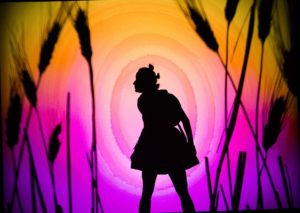 Mariko’s Magical Mix: A Dance Adventure was a collaboration with Manual Cinema, a performance collective that combines the age-old art of shadow puppetry with contemporary media. In this down-the-rabbit-hole fantasy, a young, friendless girl discovers an old turntable and a stack of LPs in the attic. Taking off her headphones to listen to a scratchy disc, she abruptly falls, Alice-like, into a supersize world. Then, like Dorothy in Oz, she picks up a couple of traveling companions – one in a waving wheat field, the other in a bustling, intimidating city.
Mariko’s Magical Mix: A Dance Adventure was a collaboration with Manual Cinema, a performance collective that combines the age-old art of shadow puppetry with contemporary media. In this down-the-rabbit-hole fantasy, a young, friendless girl discovers an old turntable and a stack of LPs in the attic. Taking off her headphones to listen to a scratchy disc, she abruptly falls, Alice-like, into a supersize world. Then, like Dorothy in Oz, she picks up a couple of traveling companions – one in a waving wheat field, the other in a bustling, intimidating city.
These locales, and the dreamlike variations in scale, are created by shadow figures on several large, movable rear-projection screens. Mariko and her friends interact with these, sometimes appearing as images within the shadow world, sometimes flesh-and-blood in front of the screens, and sometimes on both sides at once. In a rather disjointed storyline, she chases an elusive ball of light and a giant hand that’s snatched her headphones, swims to the ocean floor, scampers across rooftops, dives inside a red-eyed robot and more, before landing back home having finally found a true friend.
For me, the most intriguing aspect of the show was the witty interaction of humans and shadows, dance and setting – the interplay of gesture and geography. The three dancers playing Mariko and her companions – Natalie Liebert, Oscar Carillo and Elliot Hammans – are talented young professionals with bright futures. The choreography by Robyn Mineko Williams, however, I found rather unimaginative – an oddly disappointing partner in an ingenious concept.
Williams was also one of the choreographers in the principal company’s mainstage concert, a best-of collection of five pieces from the past 14 years. Coincidentally, her “Waxing Moon” also involved a central female paired with two male dancers competing for her attention. (On opening night they were Jacqueline Burnett, Jason Horton and Andrew Murdock, as members of the 15-strong corps shared roles in alternating performances.) Here we 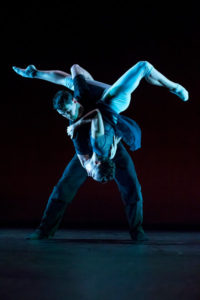 saw an interconnected flow of bodies, in contrast to the more detached relations in Mariko’s fragmented images.
saw an interconnected flow of bodies, in contrast to the more detached relations in Mariko’s fragmented images.
An excerpt from Alejandro Cerrudo’s 2013 “Second to Last” gave us five short duos which again, counter to the interlocking but individually defined parts of the traditional pas de deux, showed a synchronicity of movement and connection. Balancing taut and tender, the pairings sometimes evoked a kind of dual-stroke calligraphy, “limbstrokes,” if you will, two brushes painting simultaneously.
I particularly enjoyed the evening’s oldie but goodie, William Forsythe’s 2002 “N.N.N.N.,” a quartet driven by breath (we could hear their pants and grunts) and by the weight and momentum of their hands, which acted like pendulums or centrifugal vectors, their trajectories leading the bodies into falls, spins and careens.
Best of all were the two pieces set by Crystal Pite to radically different scores: Owen Belton’s edgy pulsing soundtrack to “A Picture of You Falling” and two Brahms cello-piano duets. The former included spoken text, including the title of the piece and “This is the sound of your heart hitting the floor,” the latter accompanied by what I took to be the rasp-thump of an echocardiogram. 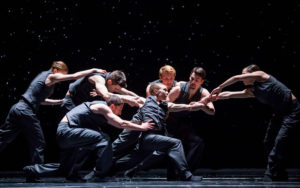 The solo performer (Jesse Bechard on opening night) became a “picture” of the soundtrack, a percussive Gumby echoing the pulsating reverberations.
The solo performer (Jesse Bechard on opening night) became a “picture” of the soundtrack, a percussive Gumby echoing the pulsating reverberations.
The mesmerizing septet “Solo Echo” was danced in a snowfall – a wave of bodies falling and rising, hands and fingers anticipating and catalyzing movement, caterpillar chains dissolving into patterned piles of bodies, then reanimating.
For all its variety, this showcase of works by four distinct choreographers shared a recognizable palette, all displaying Hubbard Street’s signature quality. Instead of discrete interactions, we witnessed organic interconnections, each dancer’s movement generated by the others’, moving in a fluid symbiosis, seeming to not only unite but meld.
The Pillow’s varied season continues this week with two diverse companies in intriguing programs. Sunset, o639 Hours, from Philadelphia’s BalletX, reimagines the first trans-Pacific airmail flight, accompanied by an onstage cabaret band. And on the festival’s intimate second stage, Zvi Gotheiner’s ZviDance performs the dance triptych Escher/Bacon/Rothko, the title being sufficient to convey its inspirations.
Photo credits: Christopher Duggan, Todd Rosenberg
If you’d like to be notified of future posts, email StageStruck@crocker.com

